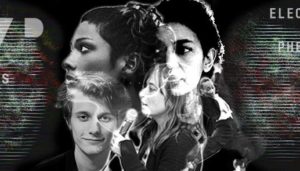“There I am, framed and saturated, bleached out of the everyday lives and social spheres of the American Whites”, writes DeForrest Brown Jr. about the cover shot for his mixtape collaboration with Kepla called The Wages of Being Black is Death. Taken by his partner Ting Ding of gender-flexible apparel line HECHA / 做, the photo of the New York-based media theorist, writer and curator was the result of many nights processing the heavy emotions of working on a record that Brown Jr. describes as “a vision of the present conditions of late capitalist civilization with the dejection and degradation of the black body at its core.”
Released by New York’s, PTP (fka Purple Tape Pedigree) on November 5, The Wages of Being Black is Death is his most recent collaboration carried out across continents with the Liverpool-based sound artist Kepla. It follows other projects with the likes of Steven Warwick, Quantum Natives and J. G. Biberkopf, as well as an earlier LP release with Kepla, called Absent Personae LP in 2017. The Wages of Being Black is Death presents Brown Jr.’s own effort to document “the alienation — and eventual distillation — of the Black Body as a subject” in America, which could be more widely read as the conclusion of an unequal distribution of power established through centuries of racial capitalism.
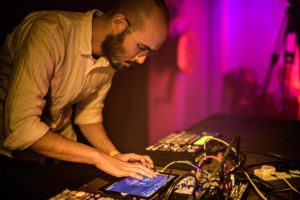
For the mixtape, Brown Jr. applies a ‘rhythmanalysis’ (see urbanist philosopher Henri Lefebvre) to the experience of the Black Body — pushing up against the ideological and physical structures that the subject navigates on a daily basis. To substantiate or make these spaces more tangible, we see Brown Jr. bury into the materiality of everyday life and draw from his immediate surroundings. In previous works, that has led him to take found sound from walks in the local Brownsville area, use recorded evidence of American police brutality and murder gone viral, and retell personal family histories. Having charted a path, the artist then establishes the grounds of critique through the use of speculative fiction — a narrative genre set in the future and often dystopian in its outlook made prominent by Afrofuturist techno producers Drexciya and continental philosopher Reza Negarestani. These fictions are presented then as a multi-faceted body of work across text, sound and performance.
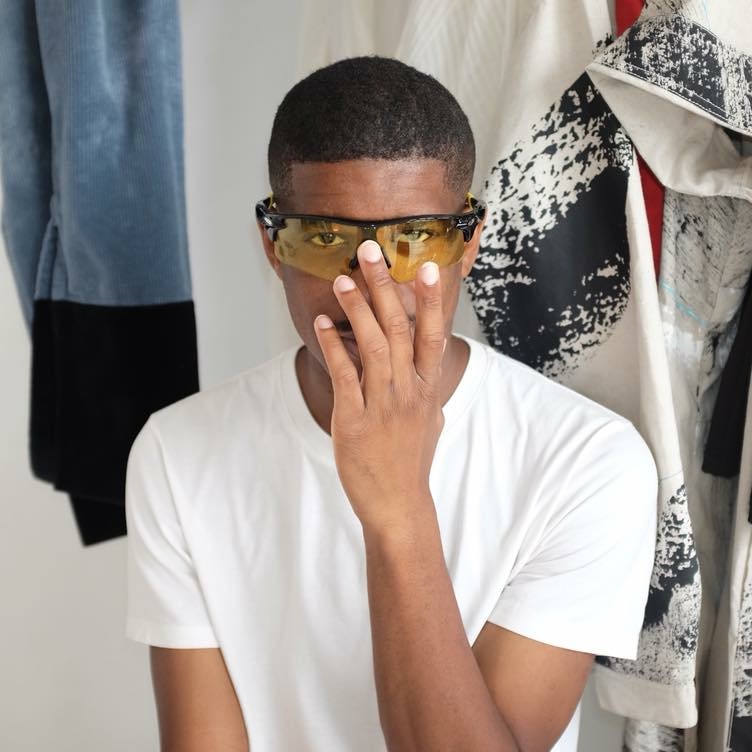
**What’s your interest in speculative fiction as a practice? And more specifically, can you talk about how it can manifest through digital technologies as a distributed network?
DeForrest Brown Jr.: Speculation is a way to design a clear perception of reality. The Lacanian conjecture of reality goes, ‘there is the Real, the Imaginary and the Symbolic,’ and Kant frames a system logic and judgement of the real through a proposed ‘fore- and background;’ where what the eyes see and the body feels is considered real, and anything beyond is imaginary or imperceivable. Basically, theatrical frames through which we perceive reality. This to me, is narcissistic and schizophrenic logic. Speculative fiction then turns the imaginary towards the real, and one can use imaginative deduction and speculation to capture an approximately clear perception of reality and your surroundings. In the context of my work, I consider curation and collaboration as modes through which one can share the worlds that others have built. Distributing media through digital networks for me is more or less a fancy and roundabout version storytelling, kinship and exploration of the transcendent and psychedelic.
**Can you introduce this speculative fiction of the Black Body, and what inspired it during the making of the mixtape?
DBJ: The initial Absent Personae text focused on connecting Eddie Gale’s records Ghetto Music and Black Rhythm Happening to the mythic underwater civilization of Drexciya, but also thinking about how Japanese electronics brand designed instruments that inadvertently empowered the black body with a direct access to automated affectual rhythm. I was interested in how jazz and techno were technologies that could spool rhythms in such a way that Africans in these two different zones could still communicate with one another … and hopefully one day rise and congeal together again.
The melancholy of the transatlantic slave trade, the literal industrializing of the black body by colonialism and American constructivist value fed into the idea of rhythm and vibration; which drumming — or “wavejumping” as Drexciya calls it — is a centuries-old communication technique that is well-established and documented in African communities.
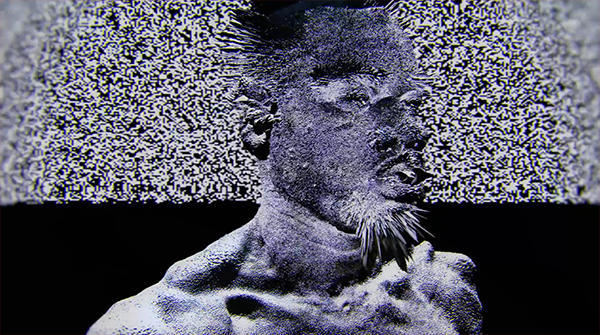
**The mixtape was impressively produced over three consecutive days, how did that process play out with one collaborator in New York and the other in Liverpool? Did working in different time zones intensify things?
DBJ: The time zones were never a problem for me and Kepla and even defined the making of Absent Personae. I’m always awake and always working, and the cycles of the day helped establish a rhythmic assembly line that really smoothed the process. The production of the mixtape was done more out of desperation and self-preservation than a desire to produce more music. After a number of exciting projects and plans had fallen through in Spring, I found myself in a position where I was so broke that food became an irregular thing for me, and I lost my home and was near the end of what I thought to be my life and horizons of living. Sometimes, being caged inside of a neutral society (especially a hypercapitalist one), while being black leaves you in compromising circumstances where there is no empathy, care or immediate solution in sight… and at that end I made a choice to live again with the help of my friends.
I had been flirting with the idea of making music for a while, especially as Kepla and I were a few proposals into developing the Substantia Nigra praxis to potentially take the Absent Personae concept into performance spaces. Incidentally, Maria Chavez asked me to create something for an event that she was hosting on Mary Mattingly’s Barge sculpture, floating off of a dock in Industry City, so I decided to try. I felt like my personal experiences of being systematically locked out of the workforce in New York while dealing with casual unconscious racism in the Brooklyn club and art scenes could be etched in between the two, and also work as a way to get out a lot of aggression and hurt that had really swaddled and beat me down throughout this past summer. So, one really awful day I wrote down the words that became the title of the mixtape, the titles of the seven tracks, all of the “lyrics,” and set a duration of around 20 minutes — an ode to Kanye’s Wyoming Sessions. I knew that I wanted the record to be a rhetorical comedy, something biting and pointed. Not necessarily because I thought my situation was funny, but because I had fallen so low that laughing was the last emotion that I felt that I had left.
**Can you talk about your interest in Henri Lefebvre’s theory of ‘rhythmanalysis’ and how you approach the task of presenting an experience that is increasingly mediated through digital technologies? How, for example, did you gather (in)tangible material for Absent Personae?
DBJ: All of my projects and collaborations are ultimately musical in nature, but extends into any constructing and filling of spaces. The practice of rhythmanalysis more or less gives a formal name to a practice I’ve incidentally developed across aesthetic experiences in my life; a multi-layered, multi-textural understanding of structures of distribution. Lefebvre lays out a four-pronged approach to measuring rhythm, in alignment with your heart and your environment. I don’t spend a lot of time thinking within that specific framework, but I do more or less consider it in the “background” as I mull over elements of everyday possibility, or behavior patterns and their potential trajectories.
For Absent Personae, I explored my body as a site of situational violence and extraction. There’s a scene in the play A Raisin in the Sun (1989) that really inspired this… where the daughter, home from college, divulges about the needlessness of a God and the power of man; her mother, the family matriarch keenly slaps the daughter with a passion and force that, for me, held a spectral quality. In a single gesture, the entire historical spectrum of black joy and pain struck her declaring that God’s name not be spoken of in vain. The daughter looked back in awe, regretting having denied God, having felt the entire weight of disparaging the symbol of Black hope, the source of rhythm.
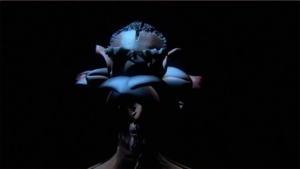
I wanted that feeling, that transcendental moment of humility at the realization (and horror) of what a black body is and can be. So I took keywords from my notes with Kepla and recited and improvised around them. I sourced a lot of audio from Brownsville where I lived at the time, and myself in various situations of exhaustion. Kepla pulled from viral media around the killing of black people by cops and an online source for gospel choir recordings and sermons. The Postscript was recorded on a really hot day in August with the heat on… I laid in the musk with my face under a pillow and spoke into my headphones mic for 11 minutes; Kepla composed through and around this recording.
**For the official video for ‘Absent Personae Postscript’ you worked with animator Chris Boyd to establish a visual location for the work. You’ll expand it further still to performance with ‘Substantia Nigra’. What should we expect from each of the performances, or how does fiction translate into this space?
DBJ: I don’t really have the time, money or enough equitable social empathy from others to ‘perform.’ So under my Speaker Music moniker, I’ve taken to staging ‘moments’ where I can be vulnerable for the sake of people seeing someone be real and authentically in pain, dismay or whatever emotion I need to bleed out within the framework of a concept. Those have mostly been practice for the upcoming ‘Substantia Nigra’ performances. The fiction element has become very site specific and focused on emotional and systemic architecture; more or less theater in negative space.

As part of the ‘Revision Suite’ group performance exhibition curated by Geng and Salome Asega for Abrons, I’ll be presenting a live iteration of the praxis that delves into ‘Black Compositional Thought,’ memory and trauma along ontogenetic rhythms. Throughout the duration of my performance, I’ll be tracing my Faulkner-esque family history and paying tribute to the ‘home house’ built by my great-grandfather in Birmingham, AL during the Jim Crow era. The music will be very ‘psychedelic’ and spiritual, but also fractured.
Prior to this, I will be staging a lecture-performance called ‘talk of racism—simmer with perverse humor‘ with Philosopher Ariel Valdez whom the project itself is dedicated to. He and I will discuss jazz as a praxis emptied of syntax and the trajectory of the Black Body as a maladjusted subject in the habitus of everyday life. Kepla and I have composed an hour of music and sound design around Ariel’s praxis of lucid dreaming and diagrammatic logic. We want to use the space and time to suss out the details of the operating system of logic that made life so hard and painful for the Black Body for so long, while offering a firm critique that can gesture towards satisfying conclusions about potential futures beyond the horizons prescribed and installed by the Whites.**
Kepla & DeForrest Brown Jr.’s The Wages of Black is Death mixtape is out via New York’s PTP Recordings on November 5. Their ‘Substantia Nigra’ performance is on at New York’s ‘Revision Suite’, St. Augustine’s Episcopal Church on November 8 & 9, and London’s Cafe Oto on November 20, 2018.
